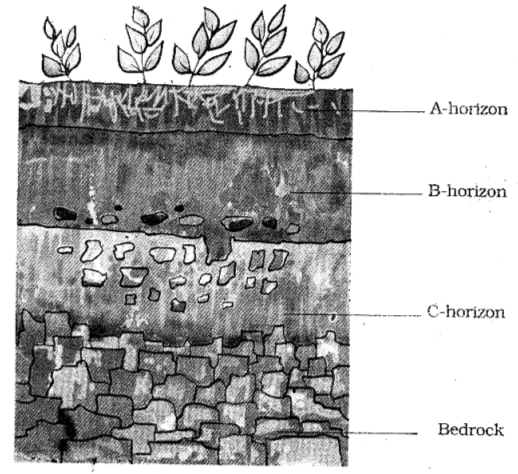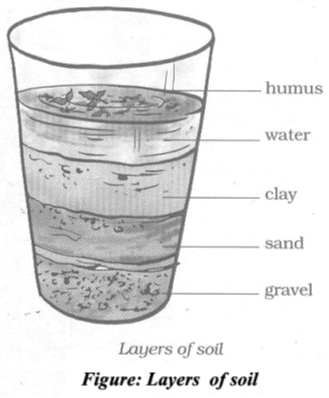Soil Profile
- Books Name
- CBSE Class 7 Science Book
- Publication
- Param Publication
- Course
- CBSE Class 7
- Subject
- Science
SOIL PROFILE
(i) A vertical section through different layers of the soil is called soil profile.
(ii) Each layer of soil profile differ in colour, depth, chemical composition. These layers are called “soil horizons”.

• Soil profile can be seen in recently dug ditch, during digging a well or laying the foundation of a building. 
• Soil profile shows three main horizons : -
A-Horizon: - Uppermost, dark coloured, rich in humus and supports plants and many living organisms like worms, rodents, moles and beetles. Humus makes the soil fertile & provides nutrients to the growing plants. This layer is generally soft, porous and can retain more water. It is also called top soil.
B-Horizon: - It is also called middle layer, which is generally harder and more compact, having less
amount of humus but more minerals.
C-Horizon: - It is made up of small lumps of rocks with cracks & crevices, called third layer. Below this is bed-rock, which is hard and difficult to dig with a spade.
• Soil profile can be observed by dissolving little soil in glass tumbler, three quarters filled with water. Each layer in glass shows different size of soil particles.
• The rotting dead matter in the soil is called humus.
Soil Types
- Books Name
- CBSE Class 7 Science Book
- Publication
- Param Publication
- Course
- CBSE Class 7
- Subject
- Science
SOIL TYPE
• Due to weathering of rocks different kinds of sand particles are formed like sand, clay etc., their ratio in soil depends on the kind of rock from which these particles are formed.
• ROCK PARTICLES + HUMUS = SOIL
• soil contain various biotic and abiotic factors. Former includes bacteria, plant roots, earthworms, nematodes etc. Later includes water, air, minerals etc.
• Classification of soil is based on proportion of soil particles of various sizes.
(a) Sandy Soil: Soil contains greater proportion of big size particles.
(b) Clayey Soil: Proportion of fine particles is relatively higher
(c) Loamy Soil: Amount of large and fine particles is almost same.
• On the basis of size, soil particles are broadly classified into following categories:
(i) Gravel or Stones → 2 mm
(ii) Sand → 0.05 to 2 mm
(iii) Silt and clay→ below 0.05 mm
• Properties of different soil depends on sizes of soil particles it have. In sandy soil, particles size is quite large so they can not fit closely together and have large spaces between them. These spaces are filled with air. Thus, soil is well aerated having less water holding capacity. Hence sandy soil is light, well aerated and dry.
• In clayey soil, soil particles are much smaller, tightly packed and having little air space. Thus, clayey soil, have little air, more water holding capacity and great amount of humus.
• Loamy is best soil for growing plants. Loamy soil contains equal mixture of sand, silt and clay soil particles. Size of silt particles is between sand and clay. Loamy soil have great water holding capacity, large amount of humus and is well aerated so, it is regarded as best soil for growth of plants.
Properties of Soil
- Books Name
- CBSE Class 7 Science Book
- Publication
- Param Publication
- Course
- CBSE Class 7
- Subject
- Science
PROPERTIES OFSOIL
Soil shows various characteristics like:
Percolation rate of water in different type of Soil
• Take three PVC pipes of about 5 cm diameter and 20 cm length.
• Select three different sites or places having soil of different types, say sandy, clayey and loamy.
• Now place the three PVC pipes about 2 cm deep in the ground (Fig. 8.8).
• Pour 200 mL water with the help of a graduated beaker in each pipe slowly.
• Note the time taken to pour 200 mL water till all the water in the pipe has seeped into the ground.
Calculate the rate of percolation for the three sites separately as follows :

Using the formula, calculate the percolation rate for soil at sites B and C also.
Greater the spaces between soil particles greater will be percolation rate. On the basis of this, properties of soil particles can be determined.
Moisture in Soil
- Books Name
- CBSE Class 7 Science Book
- Publication
- Param Publication
- Course
- CBSE Class 7
- Subject
- Science
Moisture in soil
• Soil can hold water, which makes soil moist.
• Amount of moisture in soil depends on type of soil, clayey and loamy soil have greater moisture than sandy soil.
• Due to moisture in soil, air above the land is shimmering during a hot summer day.
• Some water goes down the particles due to force of gravity is called gravitational water.
• Water held between the soil particles due to capillary action is called capillary water.
Absorption of Water by Soil
- Books Name
- CBSE Class 7 Science Book
- Publication
- Param Publication
- Course
- CBSE Class 7
- Subject
- Science
ABSORPTION OF WATERBY SOIL
(i) It depends on size of soil particles. Greater the size of soil particles lesser will be its absorption rate.
(ii) Percentage of water absorption can be calculated by experiment.
Perform this activity with two types of soil, say sandy and clayey soil.
• Take two funnels (glass or plastic).
• Place the funnels over the conical flasks or beakers. Also, place a cone of filter paper inside each funnel.
• Now put 20 gm of dry sand in one funnel and 20 gm of dry clay in another.
• Pour 200 mL of water drop by drop in the soil in each funnel. Take care to pour water all over the soil.
You will observe that the water starts dropping in the conical flask or beaker.
• Leave the apparatus for some time till the water from the funnels stops dropping.
Note the amount of water collected in the conical flask or beaker.
Calculate the amount of water retained or absorbed by the soil as follows:
Weight of soil = 20 gm
Weight of water poured in each funnel = 200 ml
Amount of water collected in the flask/beaker = x mL
Amount of water retained or absorbed by 20 gm soil = (200 – x)mL

Soil and Crops.
- Books Name
- CBSE Class 7 Science Book
- Publication
- Param Publication
- Course
- CBSE Class 7
- Subject
- Science
SOIL AND CROPS
• In different parts of India, different types of soils are found.
• Soil profile and soil structure both are affected by some climatic factors i.e. temperature, light, humidity, wind velocity, rainfall etc.
• Climatic factors, various components of soil determine various types of vegetation and crops in particular region. Clayey and Loamy soils are suitable for cereals like wheat as soil can retain water, rich in humus and is very fertile. For paddy, clayey soil rich in organic matter is good as it can retain good amount of water for long duration. Loamy soils, which drain water easily are required for lentils or masoor. For cotton, sandy-loam or loam, which drain water easily required as it can hold plenty of air.
SOIL EROSION
• Removal of top soil by water, wind or ice is called soil erosion.
• Plant can check soil erosion as their roots firmly bind the soil. That’s why soil erosion is more in those areas having little or no surface vegetation, like desert or bare land.
• Cutting of trees and deforestation should be prevented in order to check soil erosion.
SOIL MOISTURE
• The amount of water held by a soil is called soil moisture. Moisture content of soil can be calculated by formula :-

ALLUVIAL SOIL
• The soil which is formed by deposition of material i.e. silt, clay, sand and gravels carried by rivers called alluvial soil. For eg. soil of North Indian plains formed by rivers of North India which flows from Himalayas. Such soil is very fertile and supports half the population of India.
Prevention of soil erosion
Soil Conservation
The methods are as follows:
(a) Afforestation should be undertaken not only in the areas where green cover is already removed but additional areas should be brought under plantation.
(b) To reduce the effect of strong winds in the fields, trees should be planted along the boundaries of the fields.
(c) Crop rotation
(d) Proper drainage and irrigation arrangements should be made.
(e) Terrace cropping

 Grow Career Publication
Grow Career Publication
 Param Publication
Param Publication
